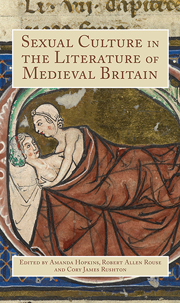Book contents
- Frontmatter
- Contents
- Introduction A Light Thrown upon Darkness: Writing about Medieval British Sexuality
- 1 ‘Open manslaughter and bold bawdry’: Male Sexuality as a Cause of Disruption in Malory's Morte Darthur
- 2 Erotic (Subject) Positions in Chaucer's Merchant's Tale
- 3 Enter the Bedroom: Managing Space for the Erotic in Middle English Romance
- 4 ‘Naked as a nedyll’: The Eroticism of Malory's Elaine
- 5 ‘How love and I togedre met’: Gower, Amans and the Lessons of Venus in the Confessio Amantis
- 6 ‘Bogeysliche as a boye’: Performing Sexuality in William of Palerne
- 7 Fairy Lovers: Sexuality, Order and Narrative in Medieval Romance
- 8 Text as Stone: Desire, Sex, and the Figurative Hermaphrodite in the Ordinal and Compound of Alchemy
- 9 Animality, Sexuality and the Abject in Three of Dunbar's Satirical Poems
- 10 The Awful Passion of Pandarus
- 11 Invisible Woman: Rape as a Chivalric Necessity in Medieval Romance
- Notes on Contributors
- Index
2 - Erotic (Subject) Positions in Chaucer's Merchant's Tale
Published online by Cambridge University Press: 05 August 2014
- Frontmatter
- Contents
- Introduction A Light Thrown upon Darkness: Writing about Medieval British Sexuality
- 1 ‘Open manslaughter and bold bawdry’: Male Sexuality as a Cause of Disruption in Malory's Morte Darthur
- 2 Erotic (Subject) Positions in Chaucer's Merchant's Tale
- 3 Enter the Bedroom: Managing Space for the Erotic in Middle English Romance
- 4 ‘Naked as a nedyll’: The Eroticism of Malory's Elaine
- 5 ‘How love and I togedre met’: Gower, Amans and the Lessons of Venus in the Confessio Amantis
- 6 ‘Bogeysliche as a boye’: Performing Sexuality in William of Palerne
- 7 Fairy Lovers: Sexuality, Order and Narrative in Medieval Romance
- 8 Text as Stone: Desire, Sex, and the Figurative Hermaphrodite in the Ordinal and Compound of Alchemy
- 9 Animality, Sexuality and the Abject in Three of Dunbar's Satirical Poems
- 10 The Awful Passion of Pandarus
- 11 Invisible Woman: Rape as a Chivalric Necessity in Medieval Romance
- Notes on Contributors
- Index
Summary
Scholarly assessments of Chaucer's fabliaux seldom acknowledge that these tales are erotic as well as funny; even less frequently do such investigations delve into why fabliaux are a source of pleasure. As Tom Hanks and W. W. Allman note in their article ‘Rough Love: Notes toward an Erotics of The Canterbury Tales’, scholars seem ‘to have averted their gaze when Chaucer's characters leap into bed’. Allman and Hanks, as their title implies, study an erotics of violence, mostly of men doing violence to women, and they focus in particular on the Merchant's Tale and its ‘erotics of stabbing’. A more positive erotic reading of the Merchant's Tale appears in Andrew Taylor's 1996 essay ‘Reading the Dirty Bits’. Taylor notes the lingering gaze of another scholar, E. Talbot Donaldson, upon a description of young May's body:
Hir fresshe beautee and hir age tendre,
Hir myddel smal, hire armes longe and sklendre,
Hir wise governaunce, hir gentilesse,
Hir wommanly berynge, and hire sadnesse.
(MT 1601–4)Donaldson writes, ‘the Spring of pretty young girls is a permanent thing, and that May in their personas will always warm the masculine heart’. Taylor suggests that pleasure taken in this description and in Donaldson's gloss of it is mimetic: ‘For the young college man to share Donaldson's and Chaucer's pleasure in May is to become, like them, a connoisseur of both good writing and pretty girls, a master of ironic detachment and well-modulated heterosexual desire’.
- Type
- Chapter
- Information
- Sexual Culture in the Literature of Medieval Britain , pp. 27 - 38Publisher: Boydell & BrewerPrint publication year: 2014



